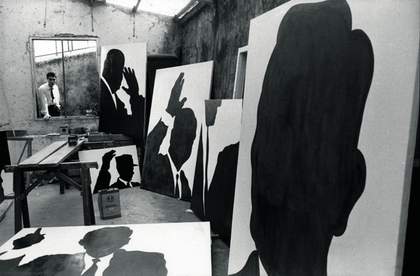Born 1939, Rome, Italy, where he lives and works.

Sergio Lombardo in his studio in 1961
Courtesy the artist
Photo: Mario Dondero
At a very young age, Sergio Lombardo abandoned his studies in law and psychology to pursue his passion for art. His first body of work, produced between 1958 and 1961, was a series of paintings made of paper squares pasted on canvas in the shape of a grid, coated with layers of monochrome enamel. Lombardo opposed the notion of the artist-as-genius, and sought to produce works that were non-artistic, drained of any subjective mark. From 1961 he grew closer to the Scuola di Piazza del Popolo (Piazza del Popolo School, also known as the Pop artists of Rome), composed of Mario Schifano, Cesare Tacchi and Renato Mambor among others, participating in some of the most important group exhibitions at the Galleria Tartaruga. As he developed a greater aperture towards the world of the mass media, he began to work on the series Gesti Tipici (Typical Gestures 1961–3), which portrayed, first in black in white, then also in colour, some of the most relevant and iconic political figures of the time, including Malcolm X, McNamara, Rockefeller, and De Gaulle.
The works Nikita Krusciov and John F. Kennedy, both from 1962, depict the black and white silhouettes of the politicians, leaders of the world’s two superpowers during the Cold War. Belonging to the series Typical Gestures (first exhibited at the Galleria Tartaruga in 1963), the works immortalise the authoritative postures, and formal clothing of the figures, which retain their unmistakeable (or ‘typical’) aura. Lombardo’s choice to use black and white, and to reduce the images to their bare silhouettes, relates to his understanding of ‘industrial aesthetics’, drawn from black and white television, and from the press. Lombardo underlined the non-figurative quality of his works, which were documents, as opposed to representations or portraits; their grand scale, and the deliberately impersonal manner in which they are represented, heightens the sense of grandiosity and iconicity attributed to his subjects, familiar to the viewer’s perception because of their omnipresence in the media.
Sofia Gotti
September 2015
